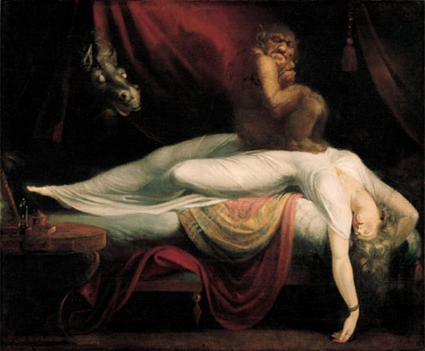Having burst into her bedroom by devious supernatural means, the goggle-eyed incubus squats on the breast of the restlessly sleeping woman in white. She is supposedly a damsel in distress, but her flushed cheeks, parted lips and general look of loose-limbed abandonment suggest that a part of her just might be enjoying her nocturnal ordeal. The demon that crouches upon her casts a shadow with devil’s horns, calling to mind the old wives’ tale that the devil visits impressionable young girls in the dead of night, to have his wicked way with them. Meanwhile the drapes above her bed have been opened by the head of a pantomime horse, with rolling white eyes and an expression of buffoonish lewdness on its dumb face.
With The Nightmare, painted in 1782, the Swiss émigré and Royal Academician Henry Fuseli brought things that go bump in the night into the realm of large-scale narrative painting. Playing on a well-established public taste for the macabre and the weird – fed in literature by the Gothic novel, a form so popular that the eminently sensible Jane Austen felt moved to produce her own pastiche of it, Northanger Abbey – Fuseli might be said to have singlehandedly invented horror as a genre of visual art.
Tate Britain’s new exhibition of painted follies and fantasies, “Gothic Nightmares”, opens with The Nightmare, its prize loan, from the Detroit Institute of Arts. The picture is hung in splendid isolation on a wall the same, blood-red colour as the curtains that hang over the young maiden’s bed. According to the exhibition’s subtitle, its theme is “Fuseli, Blake and the Romantic Imagination”. But in truth Blake is a minor presence. Its true subject turns out to be Henry Fuseli’s haunting of his adopted homeland. The organisers admit...


